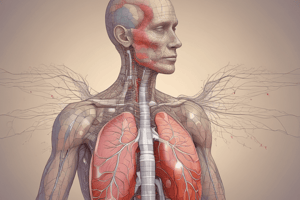Podcast
Questions and Answers
Which part of the respiratory system acts as the first line of defense against dust particles and microorganisms?
Which part of the respiratory system acts as the first line of defense against dust particles and microorganisms?
- Nose and nasal cavities (correct)
- Bronchioles
- Alveoli
- Trachea
What is the primary function of the alveoli?
What is the primary function of the alveoli?
- To produce mucus
- To facilitate the exchange of oxygen and carbon dioxide (correct)
- To filter air
- To transport air to the lungs
What is the name of the tube that connects the throat to the lungs?
What is the name of the tube that connects the throat to the lungs?
- Bronchi
- Bronchioles
- Alveoli
- Trachea (correct)
Which of the following structures are involved in the respiratory process?
Which of the following structures are involved in the respiratory process?
What is the process by which oxygen and carbon dioxide are exchanged across the walls of the alveoli?
What is the process by which oxygen and carbon dioxide are exchanged across the walls of the alveoli?
Which of the following structures are involved in the movement of air into and out of the lungs?
Which of the following structures are involved in the movement of air into and out of the lungs?
What is the primary function of the pleurae?
What is the primary function of the pleurae?
Which muscle is primarily responsible for breathing?
Which muscle is primarily responsible for breathing?
What is the role of the intercostal muscles in breathing?
What is the role of the intercostal muscles in breathing?
Which part of the brain controls the breathing process?
Which part of the brain controls the breathing process?
How does smoking affect lung health?
How does smoking affect lung health?
What happens when oxygen levels in the blood fall?
What happens when oxygen levels in the blood fall?
Flashcards are hidden until you start studying
Study Notes
Respiratory System
The respiratory system is a crucial part of human physiology, responsible for supplying oxygen to the body's cells while removing carbon dioxide waste products. It consists of several organs working together to facilitate this process. These organs include the nose, nasal cavities, trachea, bronchioles, lungs, pleurae, diaphragm, and intercostal muscles.
Nose and Nasal Cavities
Your journey towards breathing starts with your nose, which acts as the first line of defense against dust particles, tiny organisms like bacteria, and larger pollutants. This protection occurs because the air you breathe in passes through your nasal cavity where these particles get trapped by mucus produced by special glands located within the nasal lining.
Trachea, Bronchioles, Lungs, Pleurae
Once past the nose, the air travels down the throat into your trachea, also known as your windpipe. The trachea splits into two branches called bronchi, one leading to each lung. Within the lungs themselves, these bronchi divide further into smaller branches called bronchioles, which terminate in tiny air sacs called alveoli.
Alveoli are where the actual exchange of oxygen and carbon dioxide occurs. Oxygen from the alveoli enters tiny blood vessels called capillaries, and carbon dioxide from these capillaries enters the alveoli. The exchange happens across the thin walls of the alveoli, a process called diffusion.
The pleurae, a thin layer of tissue, surrounds each lung, with one layer attached to the lung and the other to the chest wall. The pleurae keep the lungs from rubbing against the chest wall and provide a lubricated space for the lungs to move during breathing.
Diaphragm and Intercostal Muscles
The diaphragm, a large dome-shaped muscle, is responsible for most of the work during breathing. It contracts and pulls downward, enlarging the chest cavity and drawing air into the lungs. When the diaphragm relaxes, it moves upwards, reducing the chest cavity and forcing air out of the lungs.
In addition to the diaphragm, the intercostal muscles between the ribs help with the mechanics of breathing. These muscles contract and expand the rib cage, contributing to the expansion and contraction of the chest cavity.
Control of Breathing
The process of breathing is controlled by the respiratory center in the brainstem, which receives information about oxygen levels in the blood. When oxygen levels fall, the respiratory center sends signals to the diaphragm and intercostal muscles to increase the rate and depth of breathing. Conversely, when oxygen levels rise, the respiratory center slows down the rate and depth of breathing.
Smoking and Lung Health
Smoking, especially long-term, affects lung health negatively. It causes chronic inflammation and damage to the airways, increasing the risk of developing chronic obstructive pulmonary disease (COPD). However, avoiding smoking can help improve lung function and reduce the risk of respiratory diseases.
Studying That Suits You
Use AI to generate personalized quizzes and flashcards to suit your learning preferences.





